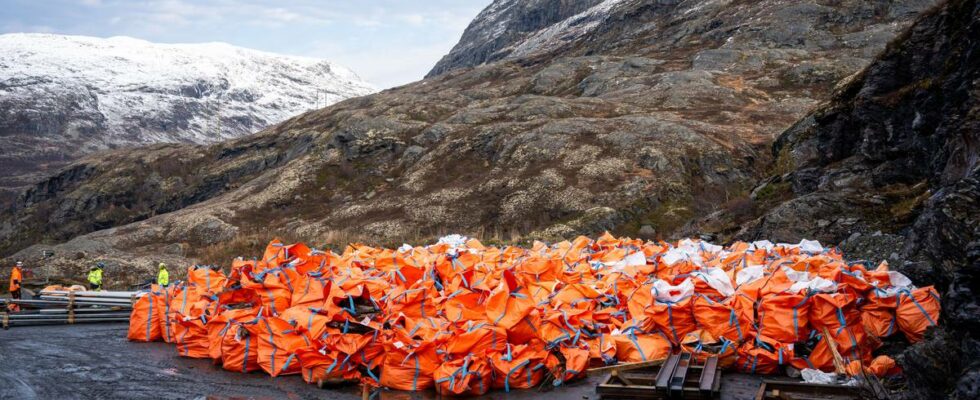The case in summary: Bane Nor has been cleaning up old sins along the Bergensbana line for eight years, and hopes to be finished in two years. The work has so far resulted in around 5,000 tonnes of different waste, including wood, railway rails, steel plates and other building materials. The Flåm line was cleared in 2022, and these are the first sections Bane Nor clears in this way. The clean-up operation costs approximately NOK 30 million annually, but much of the waste can be recycled. The logistics are a big challenge, and in some places they have to use a helicopter to get the waste away from the mountain. About 90 percent can be recycled. The summary is made by an AI service from OpenAI. The content is quality assured by news’s journalists before publication. – This is not for everyone. You must like being outside, like dramatic circumstances and think that bad weather does not exist. Project manager John Hermann Rivenes in Mesta describes the cleaning crew who, through hectic summer months, have cleared the stretch of track over Høgfjellet. John Hermann Rivenes hires a cleaning crew of 15. Photo: Oddgeir Øystese / news Between Myrdal and Hallingskeid, the railway goes cut into the mountain, shielded by overburden. On the slope below, past sins have recently been sorted out. – Here, everything has almost been brought back to naturopathy, says Rivenes. – It can feel like an eternity of work. But at the same time it is rewarding to see that there is progress. Completed in two years It has been eight years since the clearing of Bergensbana started. They started at Hokksund, and have worked their way westward since. During the next year, they hope to be finished with the mountain. In two years they may have cleared their way to Bergen, says Håkon Berge. He is a construction manager at Bane Nor. In the most inaccessible places, the waste must be transported out by helicopter. Photo: Oddgeir Øystese / news – It was a slightly different way of working in the past. When, for example, a roof structure had to be replaced, the old one was simply pushed aside. So now we clean up old sins. Berge estimates that they have so far cleared around 5,000 tonnes of various waste along the rail corridor. Timber, railway rails, steel sheets and various other building materials that were once part of the infrastructure on the line between east and west. The Flåm line was cleared in 2022. Construction manager Berge states that these are the first sections that Bane Nor clears in this way. Photo: Oddgeir Øystese / news. Facts about Bergensbanen Photo: Rolf M. Sørensen / NSB Bergensbanen is the original 485 kilometer long railway line between Oslo and Bergen via Drammen. The oldest section is the Vosse railway from Voss to Bergen, which was opened as a narrow-gauge railway in 1883 and converted to standard gauge in 1904. The proposal to build a railway between Oslo and Bergen was first put forward by forest master Hans Andreas Tanberg Gløersen in Bergensposten on 24 August 1871. The Storting decided in 1894 that the line should be led east from Voss. The section Voss–Gulsvik was opened in 1908, and the following year Gulsvik–Hønefoss and Roa–Hønefoss followed. The ceremonial opening of the Bergen Railway was made on 27 November 1909 by King Haakon 7. The Bergen Railway has around 200 tunnels. The longest are Finsetunnelen between Finse and Hallingskeid at 10,300m, Trollkona between Dale and Bolstadøyri at 8,043m and Ulriken between Arna and Bergen at 7,670m. The course’s highest point is 1,245 meters above sea level, inside the Finsetunnelen. Finse is the line’s, and Norway’s, highest station, 1,222 meters above sea level. In 1953, it was decided to electrify the Bergen Railway, and after progressing in stages, the railway was opened for electric operation on 7 December 1964. Modern express trains have a journey time of less than seven hours between Oslo and Bergen. Bergensbanen has an international reputation as a tourist railway. Source: Store Norske Lexikon Most of it is recycled The clean-up operation costs around NOK 30 million annually. But in the orange plastic sacks there are also great values. – For us, this is a treasure chest to rummage through. We can reuse a lot of this. Most of it is biofuel, but here there is also a lot of metal that we can reuse. Jørgen Nielsen from RagnSells says so. They are responsible for taking care of all waste. Nielsen says around 90 per cent of what is brought down from the mountain can be recycled. The logistics of the clean-up operation is a big challenge. In some places they have to use a helicopter to get the waste away from the mountain. Jørgen Nielsen from Ragn Sells says they can recycle around 90 percent of the waste. Photo: Oddgeir Øystese / news The orange sacks with the old sins are loaded onto a train and transported to a landfill in Voss for sorting. The mountain also offers other challenges. Winter is forcing the workers to give up for the year. – But we will keep at it until it rhymes, says Rivenes in Mesta. – The season is so short, so here it is full pedal until it is not passable up here. Earlier this summer, sacks of waste were transported down from the mountain by train. Photo: Bane Nor Published 23.10.2024, at 17.17
ttn-69
Have cleared 5,000 tonnes of waste from Bergensbanen – news Vestland

